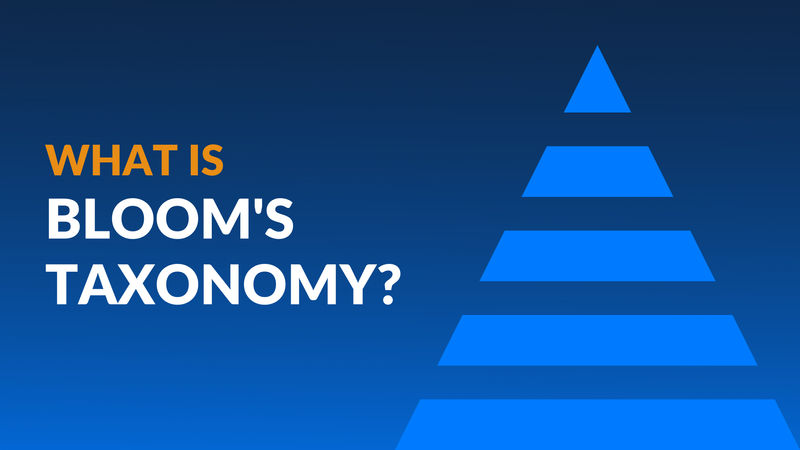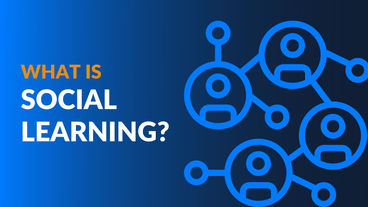
What is Bloom’s Taxonomy? Applying Learning Theory to Your Training Program
Posted on 02/01/21 By Brittany K. King
Organizations spend a lot of time and resources creating employee training programs, hoping they can successfully run on autopilot.
However, there is a major issue with the set-and-forget model.
An organization will invest in training, but never actually ensure their workers are applying the learned skills back into their jobs. Because of this, the training program is deemed a failure.
That’s why learning experts often refer to the levels of Bloom’s Taxonomy as a way to guarantee learners are equipped with relevant knowledge they can utilize on the job.
So what exactly is Bloom's Taxonomy of learning and how can organizations use it to ensure their employee training programs are effective?
What is Bloom’s Taxonomy?
Let’s break down what this theoretical framework suggests and how it was conceptualized.
First, a taxonomy is a system of classification that involves naming, describing, and categorizing different components. The name Bloom belongs to educational psychologist Benjamin Bloom, who proposed the learning taxonomy in the 1950s while working at the University of Chicago.
And so, Bloom’s Taxonomy refers to a classification of the various objectives and skills educators (or training leaders) set for their students (or learners).
The taxonomy involves different levels of learning Bloom believed represented the natural flow of learning, understanding, and applying information to real life.
The levels of Bloom’s Taxonomy fall into three core domains: the cognitive domain which involves thinking and experiencing information, the affective domain which invokes emotion and feeling in the learned knowledge, and the psychomotor domain which includes physical movement or practical application of knowledge
Over the years, Bloom’s Taxonomy has been revised to better reflect the various stages of learning. Although the levels of learning have been modified, the basic framework remains the same.
The Levels of Bloom’s Taxonomy
Currently, the six learning levels are:
- Remembering: the process of retrieving and recalling relevant information from one’s long-term memory.
- Understanding: the ability to comprehend new information via interpretation and explanation.
- Applying: the act of carrying out or implementing gained knowledge.
- Analyzing: the ability to determine how the knowledge relates to other components.
- Evaluating: the process of forming systems or theories based on criteria and standards.
- Creating: the act of compiling or reorganizing elements to produce a product or complete whole.
The chart below reflects the levels of Bloom’s Taxonomy and their supplementary action verbs:

As you can see, Bloom’s taxonomy is hierarchal, implying that learning at higher levels depends on learning prerequisite information at lower levels.
Benefits of Bloom's Taxonomy
Bloom’s Taxonomy is applied in learning environments because it is believed to encourage higher-order thought in learners by building up from lower-level cognitive skills.
In other words, the taxonomy is meant to teach learners how to receive, comprehend, and apply knowledge so that they are better equipped to process information and make more complex decisions.
There are many positive implications of applying Bloom’s Taxonomy in learning environments. Many educators believe that, at a high level, Bloom’s Taxonomy:
- Sets a universal standard for learning, from primary school to continuing education
- Encourages learners to think, reflect, and apply new knowledge
- Helps instructors create more effective agendas and coursework
Applying Bloom’s Taxonomy in the Workplace
On an individual level, Bloom’s Taxonomy can guide you through the development process – from learning a new skill all the way to putting it in action in your role.
Imagine you attend the course Create and Manage an Excel Database. Afterward, you realize that your newfound knowledge of database management could help create a new system for reporting workplace safety incidents at your organization.
You could apply the six levels of learning like this:
Remember: After you completed the course, you remembered the information you learned about Excel database management.
Understand: You identified that Excel databases can organize and summarize data for both high-level information and in-depth reporting.
Apply: You then demonstrated the advanced features of an Excel database, such as utilizing power queries to link data across spreadsheet tables.
Analyze: You compared the many features of Excel to the needs of the organization and concluded that Excel databases could be used to create workplace safety reports.
Evaluate: You then assessed the ways in which an Excel database could help streamline safety initiatives by accurately reporting workplace injuries and exposing where more safety training in required.
Create: You then created an Excel database to track, report, and examine workplace safety incidents in your organization.
The six levels of Bloom’s Taxonomy can be a helpful reference when setting learning objectives and, subsequently, assessing your company’s training program as a whole.
Here’s how you can easily apply Bloom’s Taxonomy to your employee training program:
1. Use the action verbs when writing your training objectives
When writing your learning objectives, incorporate relevant action verbs to ensure your employees are learning, understanding, and retaining important information.
Example: The junior sales staff will be able to define the seven stages of the sales cycle, assess which leads will require more attention, and compose a proper strategy to start contacting leads.
2. Apply ‘Bloom-style’ questions to help learners make connections
If you think employees need help drawing connections between their training and their job functions, ask them questions related to the learning levels to help foster deeper thinking.
Example: This project roadmap includes frequent in-person collaboration. How will that apply to the remote employees involved?
3. Reference the taxonomy to help differentiate training
Use the six learning levels to identify knowledge gaps for individual employees or departments. These knowledge gaps will uncover the training topics that may need more focus.
Example: The junior-level accountants need more payroll compliance training so they can confidently recall state and federal law requirements and assess potential problems, such as miscalculated hours and misclassifying employees.
Considerations
Although Bloom’s Taxonomy has been regarded as the universal standard for teaching and learning, you should consider its shortcomings before attempting to apply the levels to your training program verbatim.
Educational theorists have identified two key issues with applying Bloom’s Taxonomy exactly as is:
- The levels, though presented hierarchically, can be rearranged depending on individual learning needs.
- The taxonomy’s learning levels seem ‘artificial’. Labeling cognitive processes into cut-and-dry categories undermines the true nature of cognition.
Key Takeaways
Your training initiatives may not always fit perfectly into each level of Bloom’s Taxonomy – and that’s fine. The taxonomy serves as a framework for learning information and utilizing it in the workplace.
Bloom’s Taxonomy is an effective learning tool because you can refer to it as much or as little as you see fit. If your employees are struggling to apply their skills on the job, you can simply guide them through the levels of learning.
Now that you understand how the levels of learning apply to your employee training program, make sure you know how to set realistic training objectives.
Related Articles
What is the social learning theory? The theory states that people learn new behaviors through observing and imitating how others act. Here's how you can utilize social learning in on-site and remote workplaces.
In-person vs. online learning: which is better? Simply put, there are pros and cons to both. Here's what you need to know about in-person and online learning for your employee training program.
In times of downturn or financial difficulty, it is important to invest in the right places. By effectively using your learning and development (L&D) budget, you can better prepare to weather a recession, retain staff, and attract new talent.


![In-Person vs. Online Learning [Infographic] In-Person vs. Online Learning [Infographic]](https://image.lorman.com/article/blog/tr:w-368,h-207/99_in%20person%20vs%20online%20learning%20pros%20and%20cons.png)
.png)